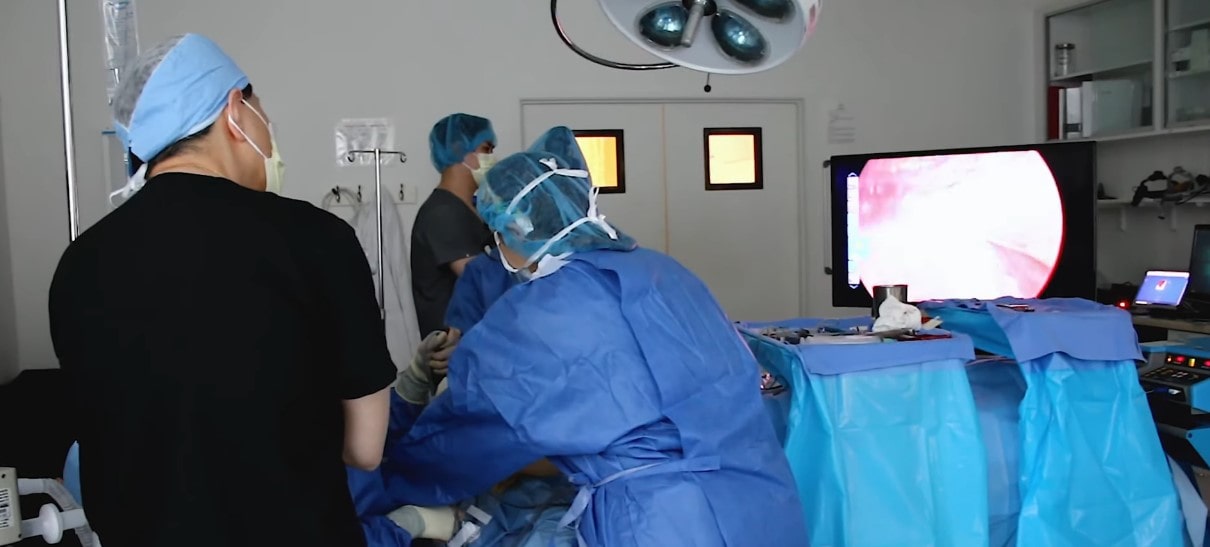
Demand for plastic surgery continues increasing. But many patients aren’t going under the knife to receive traditional forms of plastic surgery. You may be surprised by how many patients are opting for minimally invasive alternatives.
Are you interested in receiving minimally invasive plastic surgery? There are minimally invasive plastic surgery procedures to remove facial fat, treat the symptoms of aging, and even plastic surgery that uses an endoscope to make them less invasive and speed up recovery time.
Read our comprehensive guide and understand everything you need to know.
Minimally invasive procedures have similar results as surgical cosmetic procedures, except many aspects of traditional surgery aren’t used. For example, the surgeon won’t make large incisions and the patient won’t go under anesthesia.
Minimally invasive procedures use different techniques, such as micro-needling, to produce the same results without incisions. There are also specific procedures, such as endoscopic surgery.
Endoscopic surgery (endoscopy) uses a special instrument to see inside the body. The surgeon makes a very small incision to insert the instrument. Endoscopy isn’t new; this technique is used for a variety of ailments and procedures, such as tubal litigation, gallbladder removal, and knee surgery.
However, endoscopy is new in the world of plastic surgery and we’re still seeing how this method can result in ground-breaking minimally invasive results.
Endoscopy uses an endoscope to view the inside of our bodies. The endoscope has two main parts: a probe fitted with a camera and a viewing screen. The surgeon makes a small incision to insert the probe while the medical staff views the internal body’s images on the screen.
With that being said, an endoscope’s purpose is for viewing only. During surgery, the medical staff will have a wide variety of instruments for different uses. But that doesn’t mean the endoscope’s purpose isn’t significant.

How can we use an endoscope in plastic and cosmetic procedures? Here’s a breakdown of the different methods.
The endoscope can benefit certain cosmetic procedures, such as breast augmentation. The endoscope can help the surgeon position the implants correctly on the chest wall. If a patient is correcting a previous augmentation, the surgeon can use an endoscope to find scar tissue and other issues.
Another endoscopy use is in abdominoplasty (commonly called a tummy tuck). Let’s say the patient lost significant abdominal muscles. The endoscope can follow the abdominal muscles downward so the surgeon can tighten the muscles through multiple short incisions.
Facelifts and forehead lifts will also benefit from endoscope use. The endoscope prevents making large incisions, specifically in the forehead.
The surgeon can make a small incision where they will make the corrections, and the endoscope will show the surgeon where to place implants or remove muscles that produce frown lines.
The endoscope doesn’t only make cosmetic minimally invasive. Commonly reconstructive procedures are also improving thanks to endoscopy.
For example, patients with skin issues are given tissue expanders to help the skin stretch. With an endoscope, the surgeon only has to make a small incision and ensure the expander is properly positioned.
The endoscope also prevents large incisions from other serious procedures, such as flap surgery.
Flap surgery is when healthy tissue (usually from a donor) repairs another part of the body. The endoscope prevents large incisions from the donor’s side, using the camera to identify the spots of healthy tissue growth.
Endoscopes can also help a surgeon see specific bodily functions, such as nerves. In carpal tunnel release, the surgeon can make a small incision in the wrist to find the median nerve. From here, the surgeon can make a separate small incision to cut the ligament that’s putting pressure on the nerve.
Even patients with sinus problems can benefit from endoscopy. The endoscope can enter the sinus cavity and pinpoint the sinus-drainage problems. They can also find nasal polyps.
Endoscopy can achieve amazing results, in both plastic surgery as well as reconstructive surgery. But what are the specific advantages?
In traditional surgery, the surgeon will likely have to make a large incision in order to see the body. But an endoscopy enhances visibility, so the surgeon only needs to make a small incision.
As a result, the patient will only have small scars that will heal quickly. Oftentimes, these scars won’t be visible after they heal.
Endoscopy minimizes many of the post-OP side effects, such as bruising, bleeding, and swelling. Patients who receive endoscopic surgery usually recover quickly and can get back to their daily life activities quicker than they would if they had traditional surgery.
Keep in mind, minimally invasive surgery is still surgery. No surgery comes without side effects. However, endoscopic surgery does have fewer side effects than traditional procedures.
As stated previously, endoscopic procedures come with smaller and fewer incisions. This decreases the risk of common post-OP problems, such as nerve damage and sensory loss.
Because of this, many patients can return home after their operation. Traditional surgery requires a hospital stay to ensure they’re not experiencing dangerous side effects. Most endoscopic procedures are done on an outpatient basis, only using local anesthesia with sedation.
The endoscope has only been recently added to plastic surgery treatments. While we see they aid the surgeon and result in quicker recovery, we’re still researching the exact impact that the endoscope has on plastic surgery.
Other possible risks depend on the severity of your surgery. These may include fluid accumulation under the skin, infection, nerve damage, blood vessel damage, internal injuries, loss of feeling, and skin injury.
While this is rare, there’s also a chance your surgeon may need to switch to open surgery. This type of surgery comes with a longer recovery period and severe scarring.
Non-surgical cosmetic treatments use different healing techniques that don’t require surgery. Most of these treatments are performed directly at the clinic. They can treat a variety of different ailments, such as skin issues and body fat removal.
Not sure if you’re a good candidate for non-surgical cosmetic treatments? Here’s how these treatments can help you.
Different treatments such as microneedling, chemical peels, microdermabrasion, and micropens renew skin that is tired and even damaged. Your skin will be softer, smoother, and overall healthier.
For better results, patients can opt for devices that use intense pulsed light, laser rejuvenation, low-level, or radiofrequency.
Chemical peels and lasers can also correct sun damage. Chemical peels work by exfoliating the top layer of skin, reducing the appearance of uneven pigment caused by sun damage.
Different lasers, such as light laser therapy, enhance cell turnover to reduce the appearance of sunspots and redness while improving skin texture. Ablative lasers offer even better results since they vaporize the top layer of skin.
Different in-office radiofrequency procedures can treat sagging skin and jowls. This is a non-surgical and effective alternative to a facelift.
There are more body contouring options now than ever. The different devices may use a combination of cooling, heating, radiofrequency, lasers, and ultrasound to remove unwanted and stubborn fat.
Is endoscopic surgery your only minimally invasive option? There are minimally invasive facial plastic surgery and body contouring options. Here are a few other non-surgical plastic surgery procedures, treatments, and techniques.
Ultherapy is a non-invasive facelift procedure. It uses ultrasound energy to tighten and lift the skin on your face, neck, and decolletage.
The ultrasound boosts natural collagen and elastin production, producing great results with minimal downtime. Ultherapy is also more natural-looking, which is preferred by most patients.
Ultherapy is also common for specific facial treatments, such as a jaw lift and brow lift. It can lift the skin in these regions, remove fine lines and wrinkles, and more.
InMode is a company that uses different minimally invasive products, but most notably Evoke and Evolve.
Evoke is a radiofrequency energy treatment that remodels the skin and tissues on the neck, cheeks, and jawline to improve the appearance of the face and define specific facial features.
Evolve also uses RF energy and EMS to treat cellulite, remodel skin, and tone muscles. This technology has three different modes for its body reshaping functions: Tite, Trim, and Tone. This gives patients more customized results.
Skin resurfacing uses a combination of different technologies such as radiofrequency, lasers, microneedling, intense pulsed light, and even combinations of these different techniques to treat aging symptoms and skin irregularities.
Skin resurfacing works by naturally increasing your collagen and elastin levels, which strengthens the skin. Patients usually experience powerful and long-lasting results.
Some of the examples of skin issues that skin resurfacing can treat include fine lines and wrinkles, sun spots, freckles, acne, and blood vessels. You’ll not only get a more youthful complexion but your skin will be clearer and improved texture.
Chemical peels use acids to exfoliate the skin.
The acid removes damaged skin cells from the epidermis, though stronger peels remove a small part of the dermis. As long as the chemical peel was applied correctly, the patient shouldn’t experience color changes and scarring (though it may take a couple of weeks to fully recover).
Chemical peels are also popular because they’re versatile. They’re used for conditions such as enlarged pores, acne and acne scarring, redness, hyperpigmentation, and even rosacea.
Neuromodulators, such as Botox, relax the face and prevent the formation of fine lines and wrinkles.
The main ingredient in Botox is onabotulinumtoxina, which comes from the toxin in the bacteria Clostridium botulinum. Botox is delivered as an injectable into the muscle.
Botox comes in two different types: cosmetic and non-cosmetic. For example, Botox is a common migraine treatment while Botox cosmetic can reduce the appearance of crow’s feet, frown lines, and forehead lines.
Fillers are taking over the anti-aging world, as well. Dermal fillers can reduce the appearance of deep wrinkles that even Botox can’t fix. Some fillers also help accentuate the lips and other parts of the face.
Some fillers, such as Restylane Kysse, use hyaluronic acid as the main ingredient. Restylane can lift cheeks, plump lips, and smooth wrinkles.
Dermal fillers are also popular because they come with fast results and minimal side effects, usually some bruising and swelling. While the results aren’t permanent, most last several months.
There are a variety of fillers. Every filler has different lasting powers, factors for placement, and even allergy testing requirements. Always talk to your surgeon and find the best dermal filler for your needs.
Patients who want to trim their fat can choose a non-invasive procedure that isn’t invasive fat reduction surgery.
Injectables such as Kybella can melt fat around the face. SculpSure reduces fat in a target area and fat-freezing CoolSculpting gets rid of fat in specific parts of the body. Other methods improve your muscle tone, such as Emsculpt.
These methods are effective and come with quick recovery times.
As you can see, there are many minimally invasive surgery types and different techniques, such as endoscopy. No matter what method you try, you should always find a board-certified surgeon with adequate training and experience performing your chosen procedure.
But how do you find a surgeon? Since the procedure won’t be done at a hospital, the best place to look is at local plastic surgery offices in your area. It may also be worth it to travel to another city or even state to ensure you’re receiving the best service.
You can also ask your doctor for advice. While your primary physician doesn’t need to know about any elective surgeries you’re having, they may offer some advice on choosing a surgeon and where to look. They may also know a network of surgeons and can offer some recommendations.
When you find a surgeon, you’ll have a consultation before the procedure. This is where the surgeon will explain all of the details of your procedure, including where you’ll have the surgery performed (whether in the clinic or at an outpatient center).
Keep in mind, many of the procedures we covered are new. They’re minimally invasive and come with shorter recovery times, they’re not without risks.
A reliable surgeon will discuss any potential risks with you. Since these procedures are new, they may not have the most research behind their effectiveness and safety. Keep this in mind when going through with the procedure.
During the consultation, your surgeon will first get to know you and your medical history. They will conduct a complete physical exam, will ask about your medical history, and will conduct a detailed analysis of the surgery site.
From here, the surgeon will discuss the operation more in-depth, including expected results. As stated previously, they will also discuss any potential risks involved with the procedure and the side effects you’ll likely experience.
If this is your first time undergoing surgery, even minimally invasive surgery, you likely have many questions. Here are the most common questions that patients ask.
As we age, we naturally lose the collagen and elastin that gives our skin strength. In addition to making our skin look more youthful, rebuilding your collagen and elastin will help your skin recoil and you’ll have healthier skin.
Even if you don’t show aging symptoms, these treatments can act as a preventative measure.
As of now, Botox and dermal fillers are the most common procedures. They’re effective, the procedure is quick and simple, recovery time is low, and patients see results quickly. But other methods, such as chemical peels, are becoming more common.
Aging symptoms, such as wrinkles and dark spots, are a common concern for many patients. While aging is common and happens to just about everyone, these aging symptoms can make patients feel insecure and will want a more youthful appearance.
So, what is the best procedure for your aging symptoms? It depends on what you want to correct. Botox is the best option to correct fine lines on the forehead, crow’s feet, and “smile lines” around the eyes.
Dermal fillers are best for deeper wrinkles, such as “laugh lines” on the cheeks. These treatments rebuild your collagen and elastin levels, producing incredible results.
If your lines aren’t prevalent or you want to prevent them, try non-surgical skin treatments such as chemical peels, lasers, and microneedling. Your surgeon will also recommend treatments, depending on the severity of your wrinkles.
What if sagging skin and jowls is your concern? We suggest laser treatment. For example, InMode’s Evoke uses radiofrequency to tighten the skin.
The specific aftercare you do depends on your treatment. After Botox, avoid using other skin treatments and don’t touch your face for at least a day. You’ll also want to stay out of the sun.
After dermal fillers, you’ll want to avoid touching your face and using skincare products except for the ones that the clinic provides. Don’t exercise or do any strenuous activity for at least a week after treatment.
Bruising, redness, tenderness, swelling, and itching near the injection site are common side effects. If you experience anything more serious, be sure to contact your doctor.
When you receive approval from your doctor, you can practice proper skincare. Use a face wash, toner, and moisturizer. When walking outside, always wear sunscreen. Inform your doctor if you have prescription skincare products or want to use strong masks and exfoliants.
There are also specific skincare steps after receiving a chemical peel. Rinse your face with cold water and apply a moisturizer. Never leave the house without sunscreen. Don’t exfoliate your skin and avoid strenuous exercise.
Liposuction is a popular cosmetic treatment that removes excess far from the body. Many patients receive liposuction as a last resort if diet and exercise aren’t resolving their weight issues. However, liposuction is an invasive surgery and comes with many side effects.
If you want a minimally invasive alternative, many patients are turning to body contouring. This is a non-invasive procedure that “sculpts” different parts of the body.
There are many body contouring procedures, but the two most common are CoolSculpting and Sculpsure. CoolSculpting freezes the fat while Sculpsure delivers a heating laser through the skin to damage and remove fat.
Keep in mind, body contouring doesn’t offer the same results as liposuction. Body contouring is a great option for patients who aren’t overweight but want to shed a small amount of excess fat.
Liposuction is ideal for those who are overweight and struggle to shed extra pounds. This procedure produces great results that are long-lasting.
Endoscopic plastic surgery is ideal for all patients. It’s a flexible procedure, the surgeon only needs to make small incisions, and recovery time is usually shorter.
Keep in mind, intense plastic surgery requires larger incisions. Discuss with your surgeon whether endoscopic plastic surgery is right for your procedure.
Do you want to get minimally invasive plastic surgery? If so, there are more options for you than anything.
Different cosmetic procedures require no surgery, such as facial treatments and body contouring. If you do need surgery, endoscopic surgery helps reduce recovery time by offering the surgeon more internal visibility.
The next step is to find the best surgeon. If you’re in California, you don’t have to look too far. Our clinic specializes in both surgical and non-surgical procedures. We have clinics based in Los Angeles, San Francisco, and more.
Contact us for a consultation today.
